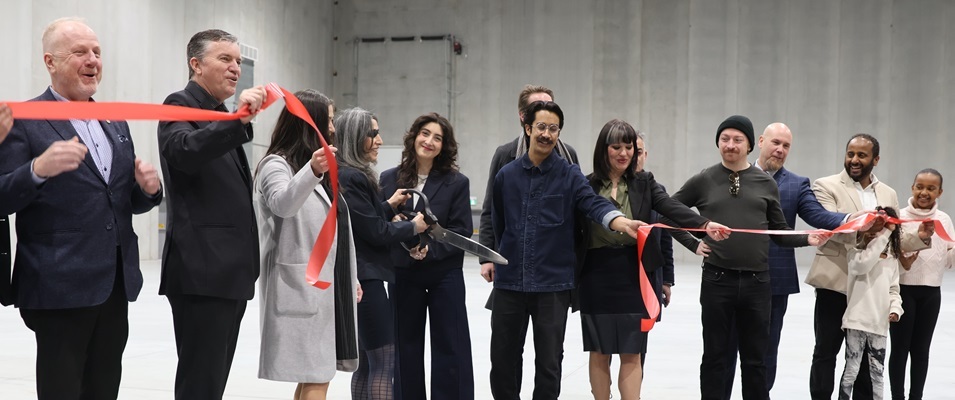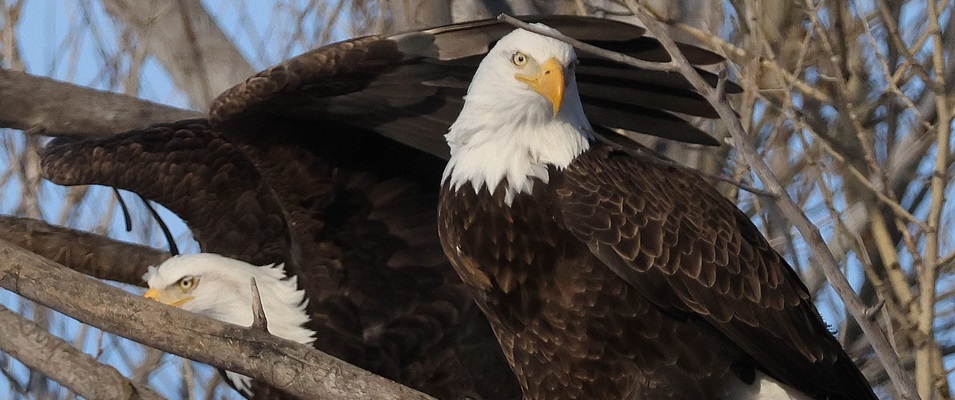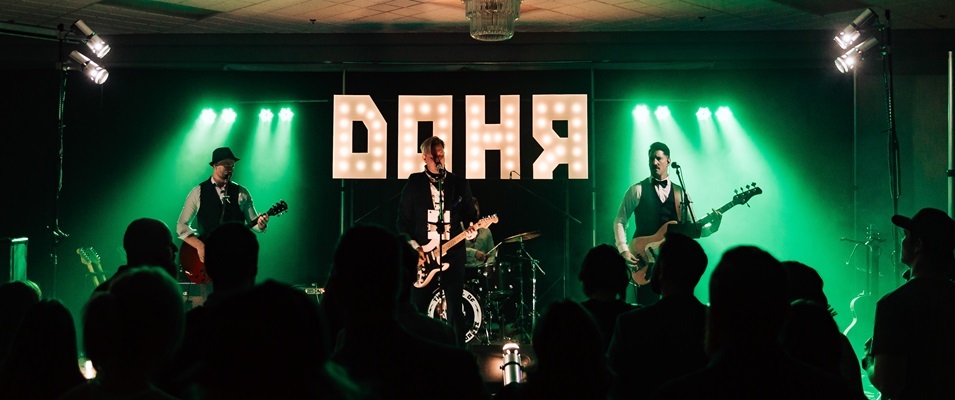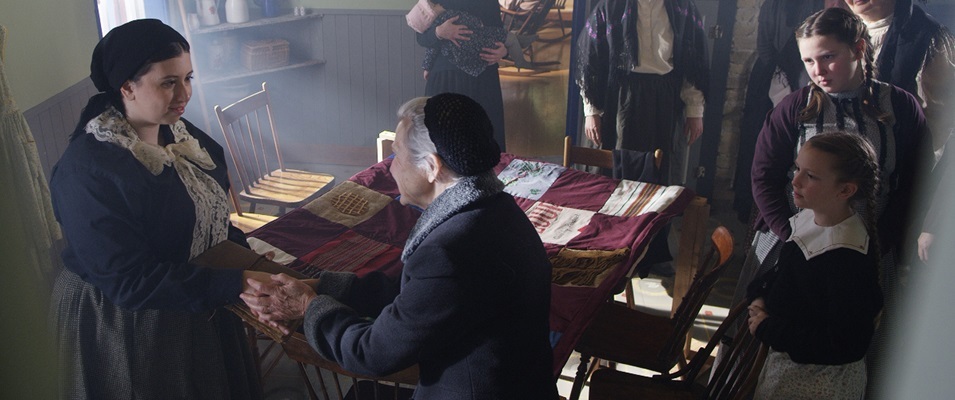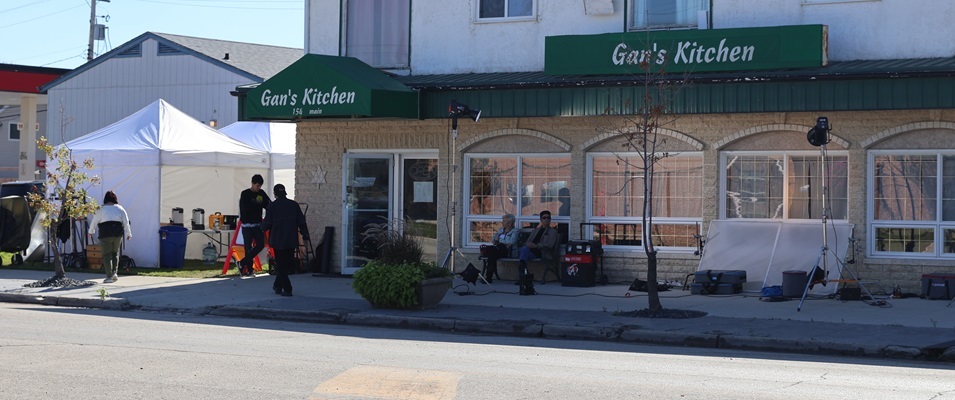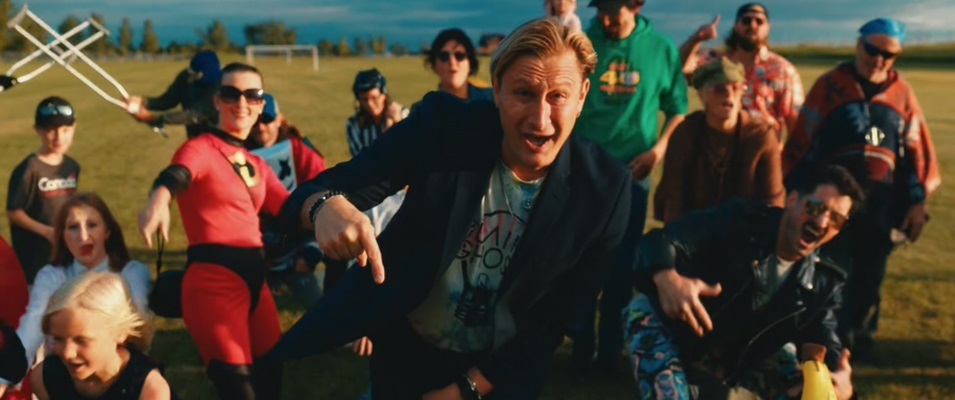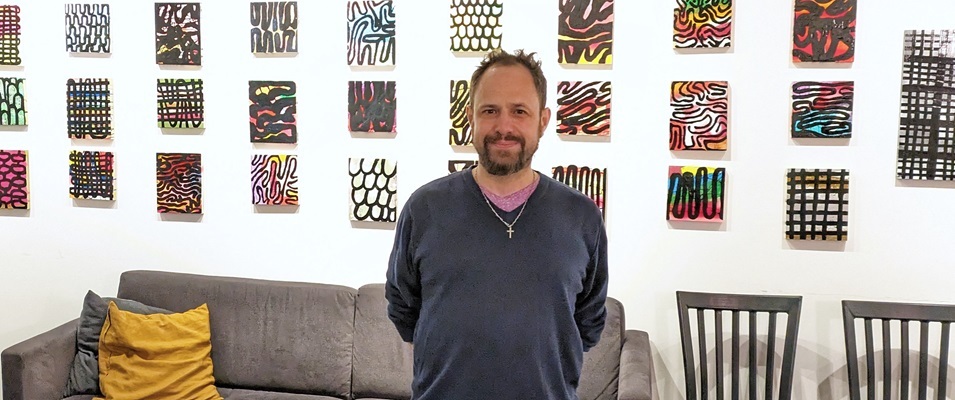
Since mid-December, Niverville-based artist Daniel Dueck has been presenting an exhibit of 70 new paintings at The Public Brewhouse in Steinbach. Entitled “New York to Niverville—New Works,” the work explores rhythm, pattern, and sequence in an abstract collection that is bold, colourful, and graphically whimsical.
Typically, Dueck says that he gravitates toward idealized representational landscapes, only dipping a toe into the world of abstraction.
Since it’s been more than five years since the local artist presented work publicly, he wanted to make a comeback statement, giving people an invitation to step out of the elitism of art world norms and interact instead with work that is unexpectedly fun.
Using the materials and traditions of street art, Dueck uses wood panels which he makes himself. He comes at them with humble spray paint to build layers of colour topped with a high-contrast black applied in organic patterns and sequence.
“I tend to use a lot of stuff you can get from your hardware store, like the Tremclad paints you could paint your bikes with. It’s not about graffiti, but there is an influence,” says Dueck.
Paint has long been his material of choice. He finds that it speaks to the way his creativity flows.
Dueck’s body of work is developed through the use of layers. His starting point lies underneath the surface of the final piece. After adding layers of colour, the viewer might not see a hint of the original base colour.
As each of these new works emerged, Dueck envisioned the highly contemporary, colourful collection displayed on a stark white wall, allowing the art to speak. He also wanted each piece to be approachable and fun. The Public Brewhouse in Steinbach offered such an environment.
Alexandra Ross, co-owner and curator at The Public, says that when they came up with the gallery aspect of their business they decided to focus on the intersection of contemporary and rural-based Manitoba artists.
“Typically, the artists we feature are more emerging, but [Dueck] is an established artist, which we are super excited about,” said Ross.
She learned about Dueck’s work history and achievements, then visited his home studio to get a sense of his style.
“Daniel had his old body of work, which was representational, and then it was this new body of work that I wanted to exhibit,” she says. “His representational work has a lot of the same materiality to it, but maybe one of the risks with rep work is that you can take it at face value and Daniel’s work is more complicated than face value.”
Ross says that she resonated with Dueck’s idealized landscapes and pop culture art, but there is a fantastic invitation that happens when you see abstract work.
“It challenges the viewer to spend a little bit more time on it… sometimes you can get lost in the world that is supposed to be elite art and you forget about the fun that art can be,” she says. “Abstraction is a wonderful invitation to have fun. No one is telling you, ‘This is a tree.’ We don’t know what it is. So we’re allowed to participate with the artist in creating in our minds what the art piece actually is.”
The exhibit will run until March 9, 2024.
Returning Home
Dueck grew up in the St. Vital neighbourhood of Winnipeg and started making art when he was just four years old. He received his BFA at the University of Manitoba’s School of Art in 1997 and holds an MFA from the Museum of Fine Arts at Tufts University, Boston, which he completed in 2002.
He has been awarded numerous grants and teaching fellowships and his work has been exhibited both nationally and internationally. It is held in collections of the Winnipeg Art Gallery, Tufts University, Deutsche Bank, and the Children’s Hospital.
He spent a number of years living and working in New York. Like many artists, work slowed during the COVID-19 pandemic and he found himself thinking about moving back to Manitoba.
As an only child who was always close with his parents, Dueck found himself agreeing to move to Niverville after they relocated to gain a better appreciation of small town life.
“Now I’ve been in Niverville for about three years,” says Dueck. “It feels like home, because this is actually closer to where my ancestors came and settled. Home is where the heart is, and being a Manitoban, it’s kind of weird. You can live anywhere and I’ve lived in a variety of cities and states, but you always come across people who lived in Manitoba.”
Dueck enjoys the way in which people are able to get to know each other better in small towns. And it doesn’t hurt that he has other extended family here as well.
“I have aunties and cousins, literally, on every other block,” he says. “In the city, I never had that. It’s really great.”
The Creative Life
Aside from art, Dueck is a skilled carpenter and works for Southern Health. But it’s the creative side of life that fuels his passion.
“Creativity is essentially giving birth,” he says. “You’re creating something from nothing. And all artists will tell you, you can’t stop it.”
One of Dueck’s earliest memories is using a paint-by-number kit. As an adult, he then took work as a commercial painter to pay the bills.
But colouring inside the lines was never going to be enough.
“I’ve been making art since I could draw. A drawing is any distance that creates a line from A to B. But with paint, one day it’s purple, the next day it’s white. And with painting murals, there are many, many layers sometimes. With my work, I can go over it if I don’t like it, and sometimes I do, again and again, and then there’s like this ghost of the painting inside the painting. I know what used to be there, but it’s not there and no one else would know what used to be there.”
While trained in a variety of artistic disciplines, Dueck has returned to drawing and painting rather than sculpture or other media.
“My main medium is 2D and I use a mixed medium,” he says. “Crayon, spray paint, pencils. Contemporary oil painting, acrylic, collage. I have done 3D work before; those works are scarce in terms of my practice. I tend to think that I’m a lover of paint. Paint is part of my life. I understand it.”
Dueck credits the encouragement of many mentors and teachers with inspiring him to study art professionally. And studying gave him the discipline to make work, which lead to bodies of work that he is now proud to share and exhibit.
While discipline is important, he acknowledges that treating art like a business can quickly block creativity.
“I’ve had different processes, where I do it when I want to, or I do it like a discipline, Monday to Friday, professionally going to the studio. I’ve seen that working, like being a business, but it takes encouragement. Once you get successful, you feel like you need to maintain what you’re doing. At times I’ve had artistic depression… There have been hiatuses in my work and mental health will kick you in the butt and you have to take a break. And that’s okay. You’ll come back to it. It’s compelling.”
Dueck describes being an artist like having an addiction; if you don’t make the work, you don’t feel good. And at this point in his career, he has found a creative process that enables him to create art consistently in a fun and healthy way.
“When I’m inspired, I’m articulating my mind’s thought. I’m expressing my feelings through a mind thought, then through a medium. If I was a dancer, I would dance. If I was a poet, I’d make a poem. I’m an artist, so I paint.”
There is a lot of creativity in southern Manitoba and Dueck encourages any budding artist to continue to pursue their dreams.
“Commercial success is statistically hard to achieve,” he says. “It’s like a thousand hours that you should put into your discipline. And then people say it’s location, location, location. And then it’s luck. But without art, there is no culture. And without culture, what do we have? Pursue your dreams. You never know what’s going to happen. Pursue it.”





